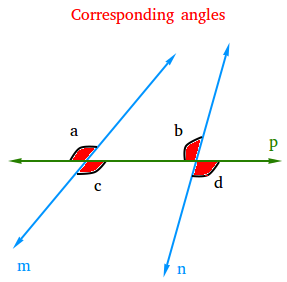What are Corresponding Angles? Definition and Examples
What are corresponding angles? Corresponding angles are formed when a line, called transversal, cuts or intersects two or more lines.
In the figure below, line p shown in green is the transversal or the line that cuts or intersects two lines ( line m and line n ).

Here is how to identify corresponding angles
- They are on the same side of the transversal
- One is located inside the lines the transversal cuts or intersects.
- The other is located outside the lines the transversal cuts or intersects.
Angle a and angle b are on the same side of the transversal or line p. Angle b is located inside line m and line n. Angle a is located outside line m and line n. Therefore, angle a and b are corresponding angles.
By the same token, angle c and angle d are on the same side of the transversal or line p. Angle c is is located inside line m and line n. Angle d is located outside line m and line n. Therefore, angle c and d are corresponding angles.
When a transversal intersects two lines, four pairs of corresponding angles will always be formed.